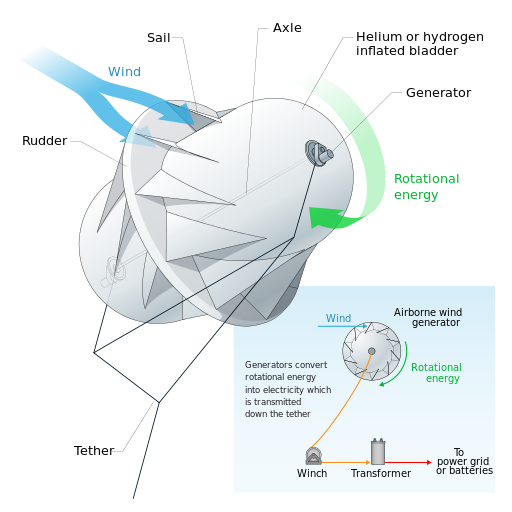
Airborne Wind Energy
Keith D. Foote
Airborne Wind Energy is also known as High Altitude Wind Energy, and is a new form of renewable energy technology. It uses airborne devices to generate power. Unlike conventional wind power which uses wind turbines on tall poles, or far out at sea, airborne wind energy uses floating devices such as balloons, kites, and tethered wings suspended high in the air.
Many of the well established technologies currently being used in conventional ground-based wind turbines, also apply to airborne wind technologies. What makes airborne wind turbines different from their ocean or land based counterparts is the way in which they take energy from the wind. Instead of a large steel tower, a tether cable anchors the system to the ground. Instead of long rotating turbine blades, specially designed aerofoil kites and wings sweep across the sky to extract the winds energy.

Source: James Provost via commons.wikimedia.org
When children fly a kite, there is a lot of pulling power from the wind. This "pulling power" is used by airborne kite boards and kite buggies as a form of propulsion. However, we can also use the same pulling power and lifting force to generate a cheap and abundant supply of electricity using airborne wind turbines. Airborne wind energy devices, such as a tethered wing or an aerofoil kite, are electro-mechanical systems capable of transforming the kinetic energy of the winds.
Most airborne wind power devices are designed to fly in a crosswind, allowing them to concentrate the winds immense power at medium to high altitudes. This is because at altitudes above 200 meters, the winds speed is generally higher and more consistent than nearer to the EarthÂ’s surface. These high winds can be used as an energy source and generate power more consistently. Additionally, the lift and forces produced by the wind at these altitudes can both support the airborne device and generate significant power. Since these airborne wind devices operate at a greater altitude with stronger wind speeds, more electricity can be generated.
Conventional wind turbine towers, even as high as 100 meters, simply cannot achieve the same results of power and consistency. Even locating wind turbines high on the tops of mountain ranges does offer a significant increase in power conversion. Airborne wind energy devices are mechanically connected or tethered to the ground so as to maximize the relative velocity between the wind's movement and the "stationary" ground.
Capturing the winds power from these high altitude winds requires devices based on aircraft technologies, such as: aerofoil kites, sky-sails, gliders, and sail-planes. Theses devices can be connected to a stationary ground station to produce electricity, or to another moving, but non-flying object to produce traction power, such as the rotation of a flywheel.
Airborne wind turbines generally generate power using a ground based generator, attached to the tether cable winch. It generates electricity as the kite or aerofoil pulls out the cable. The torque and velocity of the tether cable generate electricity by rotating the winch drum, in turn drives an electrical generator.
In ground based generator systems, electricity is generated as the tether cable is reeled out until the maximum tether length, or altitude, is reached. The next step involves the retraction of the tether cable, which is wound back onto the drum. The winching in of the tether cable uses only a small amount of electricity, with the generator becoming a motor drive to retract the cable. Once the tether cable is fully rewound onto the drum, the generation process starts once again. The reel-in and reel-out movement of these airborne devices with a ground-based generator are often called "Yo-Yo" generators.
Airborne generator systems are much more like airplanes than kites. They have on-board, computerized autopilot systems and flight controls. Instead of engines and propellers, these plane-like devices have turbines and on-board generators. They generate electricity as they glide in the wind. The downside of these airborne wind energy devices is the tether, which has to both conduct electricity and withstand the strong pulling tensions of the wind, including bad weather.
While the electrical generator and winching mechanisms of these energy systems are located on the ground, the lightweight flexible wings, aerofoils, and surf kites sweep a path across the sky to extract the kinetic energy. Airborne based generators which use rigid wings that resemble a fast flying tethered aeroplane or the tips of wind turbine blades can also be used to generate electricity.
Wind energy is now one of the most advanced technologies for capturing renewable energy. In crowded areas, where energy production is needed the most, land space is limited. This has lead to a strong focus on "offshore" technology for future investments. Airborne wind energy is an option that could be especially useful in the offshore wind market. Offshore wind energy has much greater energy potential, because wind speeds are higher over the oceans.
Replacing the large and bulky structure of a turbines tower with a lighter and more efficient tethered wing may need to be considered. The wind resources at high altitudes is very promising and compared to the lower height of pole-based conventional wind energy, is much more efficient. Airborne wind energy systems, however, are not without their disadvantages:
-
Bad weather, such as thunder and lightning, pose a very serious risk to any airborne device.
-
No power can be generated if the device is retracted during bad weather.
-
If the power cables may become detached or damaged falling to the ground, the device becomes a safety hazard.
-
Unless alternating current is being generated, a direct current line will lose energy traveling over a long cable.
-
The tether must survive many duty cycles of varying load, and consequently, must be very heavy.
Airborne wind energy is a relatively new technology and industry, but the ideas and concepts already developed have a great deal of promise. There may come a day when we see giant kite-like generators on a regular basis.